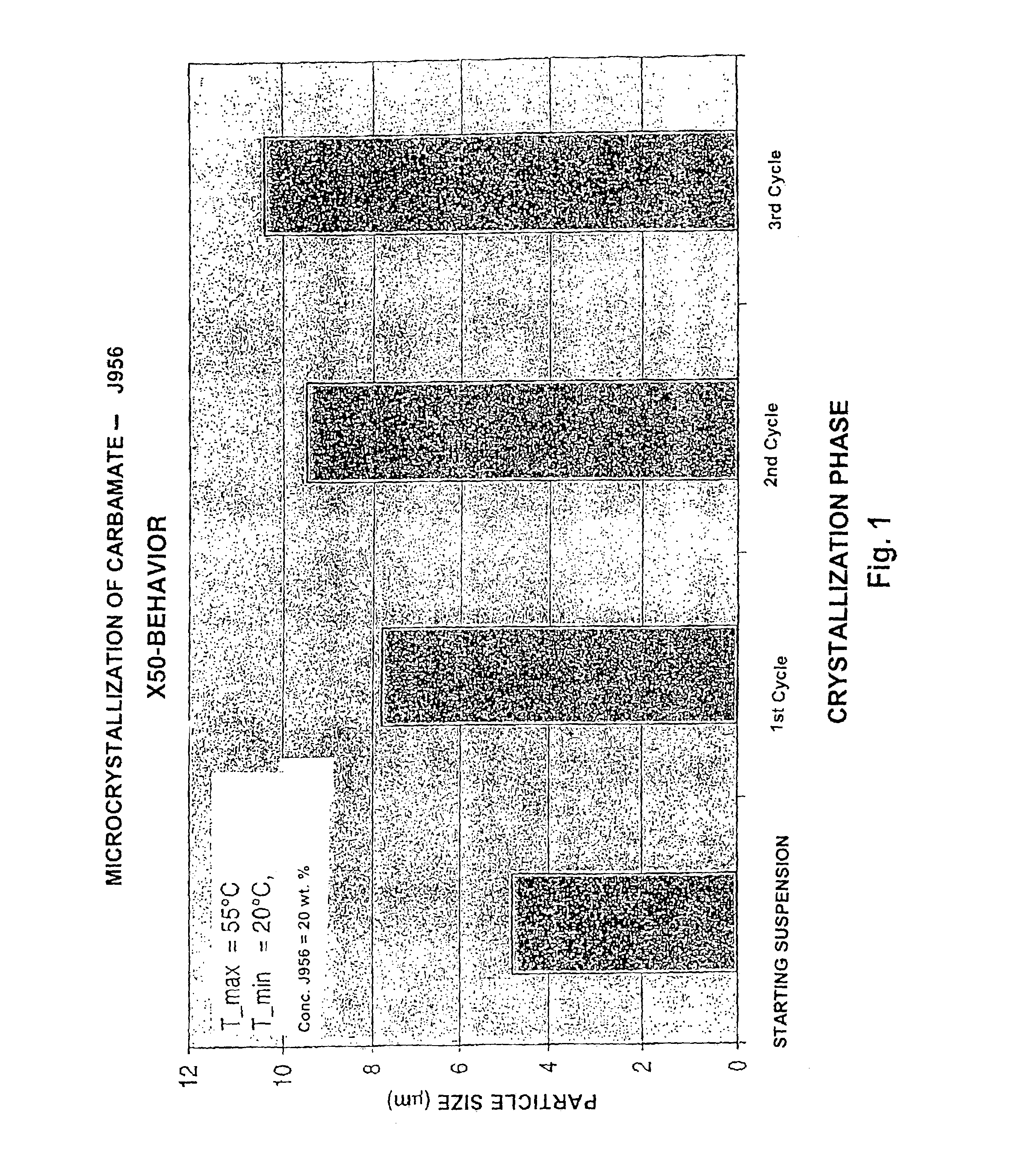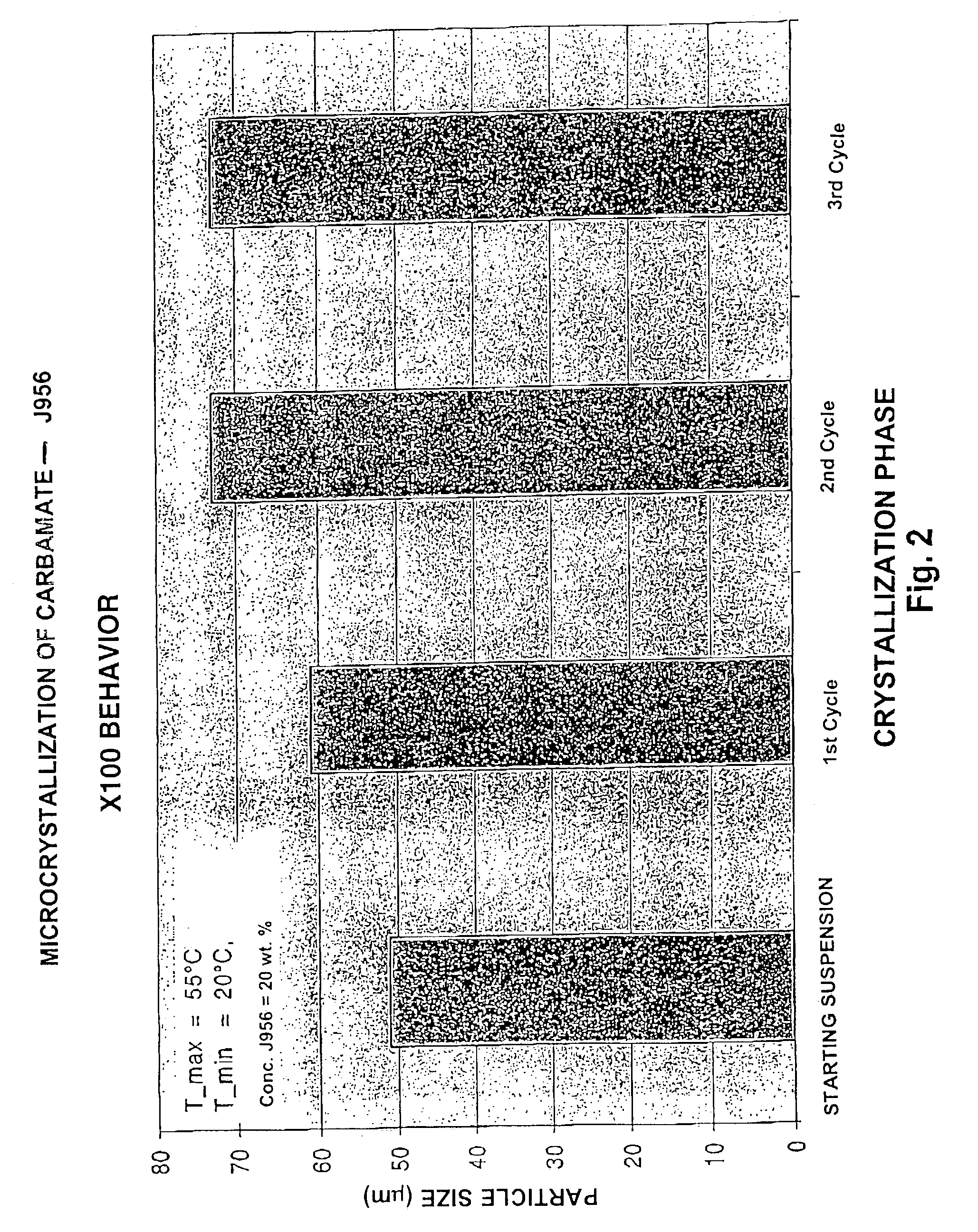Process for production of steroid crystals, steroid crystals obtained thereby and pharmaceutical preparations containing them
a technology of steroid crystals and steroid crystals, which is applied in the direction of biocide, organic chemistry, drug compositions, etc., can solve the problems of affecting the dissolution properties and particle size changes, affecting the dissolution effect and particle size distribution, and achieving high accuracy and reproducibility
- Summary
- Abstract
- Description
- Claims
- Application Information
AI Technical Summary
Benefits of technology
Problems solved by technology
Method used
Image
Examples
example 1
[0066]In a glass reactor with an anchor agitator and a double-wall heating / cooling jacket 250 g of J956 are dissolved in 1100 ml ethyl acetate at 70° C. The clear solution is cooled for 30 minutes at 35° C. A rotor-stator dispersing apparatus (Ultra Turrax, T25 basic, with S25N-25F) is used to prepare this solution. It is operated with a rotation speed of 12000 to 18000 rpm. After 2 to 5 minutes crystallization begins. The Ultra Turrax is operated for an additional 10 minutes and then is shut off.
[0067]The starting suspension obtained is heated at 55° C. and subsequently cooled within an interval of 1 hour 20 minutes to 20° C. This procedure is repeated still twice more.
[0068]Subsequently the filter cake is dried with air.
[0069]Microcrystals are obtained with the following particle size distribution:
[0070]
Particle size (μm)X102.62X5010.4X10073
example 2
[0071]In a sulfonation flask with a blade mixer and a heating / cooling bath 50 g of J956 are dissolved in 200 g of ethyl acetate at 70° C. The clear solution is cooled for 15 minutes at 35° C. A rotor-stator dispersing apparatus (Ultra Turrax, T25 basic, with S25N-25F) is operated with a rotation speed of 12000 to 18000 rpm to prepare the solution. After 2 minutes crystallization begins. The Ultra Turrax is operated for an additional 10 minutes and then is shut off.
[0072]The starting suspension obtained is heated at 50° C. and subsequently cooled within an interval of 1 hour at 20° C. This procedure is repeated still twice more.
[0073]Subsequently the suspension is filtered by means of a frit and washed with 100 ml MTBE. The filter cake is washed with 1000 ml water very thoroughly and subsequently suspended with 300 g water. The suspension is spray-dried under the following conditions in a laboratory spray-drier with two nozzles (2 mm) (QVF / Yamato):
[0074]
Drying gas entrance temperatur...
example 3
[0077]In a glass reactor with an anchor agitator and a double-wall heating / cooling jacket 270 g of J956 are dissolved in 1200 ml of ethyl acetate at 75° C. The clear solution is cooled for 30 minutes at 38° C. The solution is circulated from the crystallizing vessel bottom outlet and is then fed back into the crystallizing vessel by means of an external rotor-stator dispersing apparatus (IKA laboratory Pilot 2000 / 4 with DR module). The rotor-stator dispersing apparatus is operated with a rotation speed of 9000 rpm. After 2 to 5 minutes crystallization begins. The rotor-stator dispersing apparatus is operated for an additional 10 minutes and then is shut off.
[0078]The primary particle suspension obtained is heated at 50° C. and subsequently cooled within an interval of 1 hour 20 minutes to 20° C. This procedure is repeated still twice more. Subsequently the filter cake is filtered by a frit and washed with 500 ml MTBE. The filter cake is dried by suction with air.
[0079]Microcrystals ...
PUM
| Property | Measurement | Unit |
|---|---|---|
| particle size | aaaaa | aaaaa |
| particle size | aaaaa | aaaaa |
| grain sizes | aaaaa | aaaaa |
Abstract
Description
Claims
Application Information
 Login to View More
Login to View More - R&D
- Intellectual Property
- Life Sciences
- Materials
- Tech Scout
- Unparalleled Data Quality
- Higher Quality Content
- 60% Fewer Hallucinations
Browse by: Latest US Patents, China's latest patents, Technical Efficacy Thesaurus, Application Domain, Technology Topic, Popular Technical Reports.
© 2025 PatSnap. All rights reserved.Legal|Privacy policy|Modern Slavery Act Transparency Statement|Sitemap|About US| Contact US: help@patsnap.com


